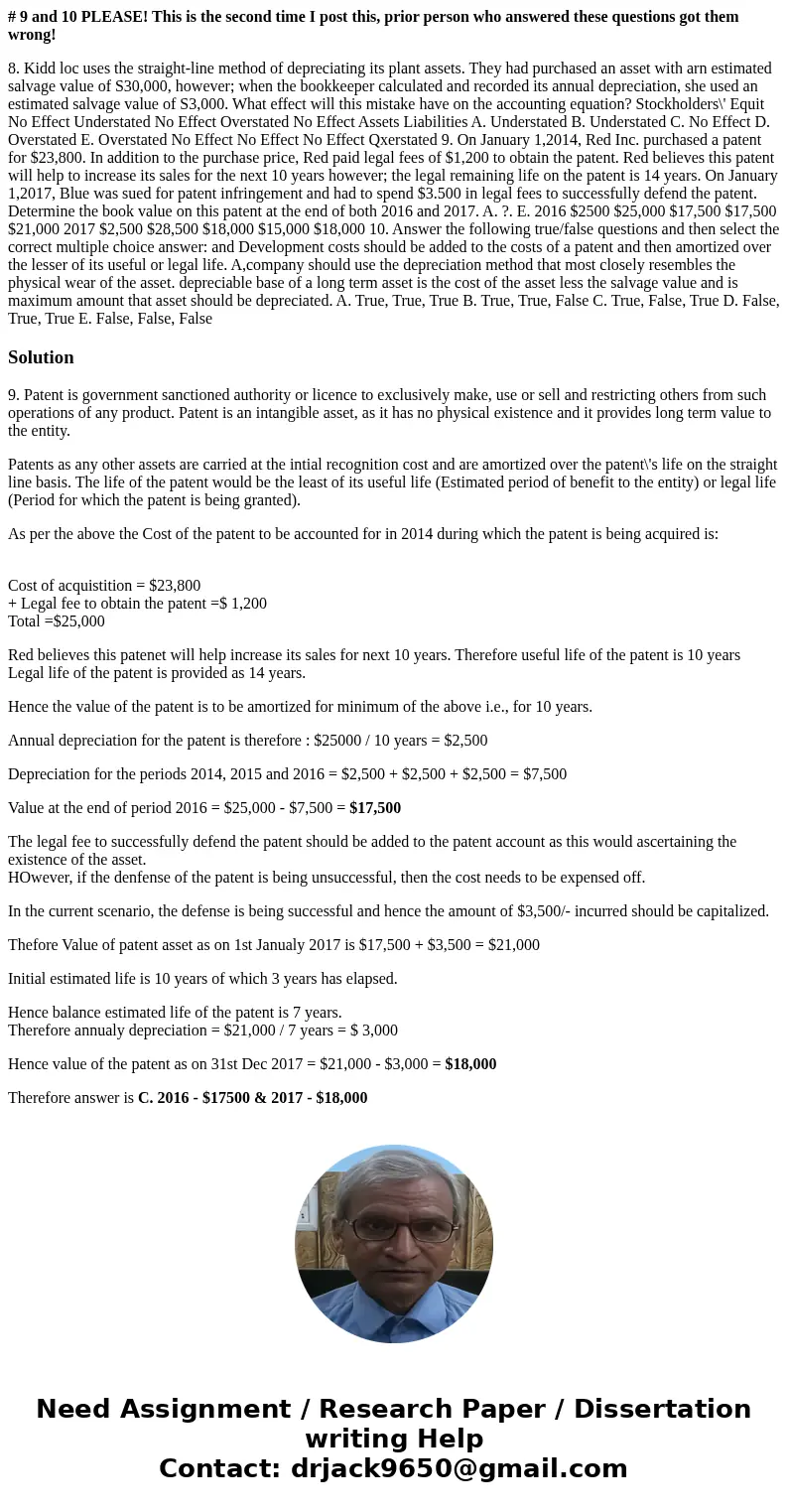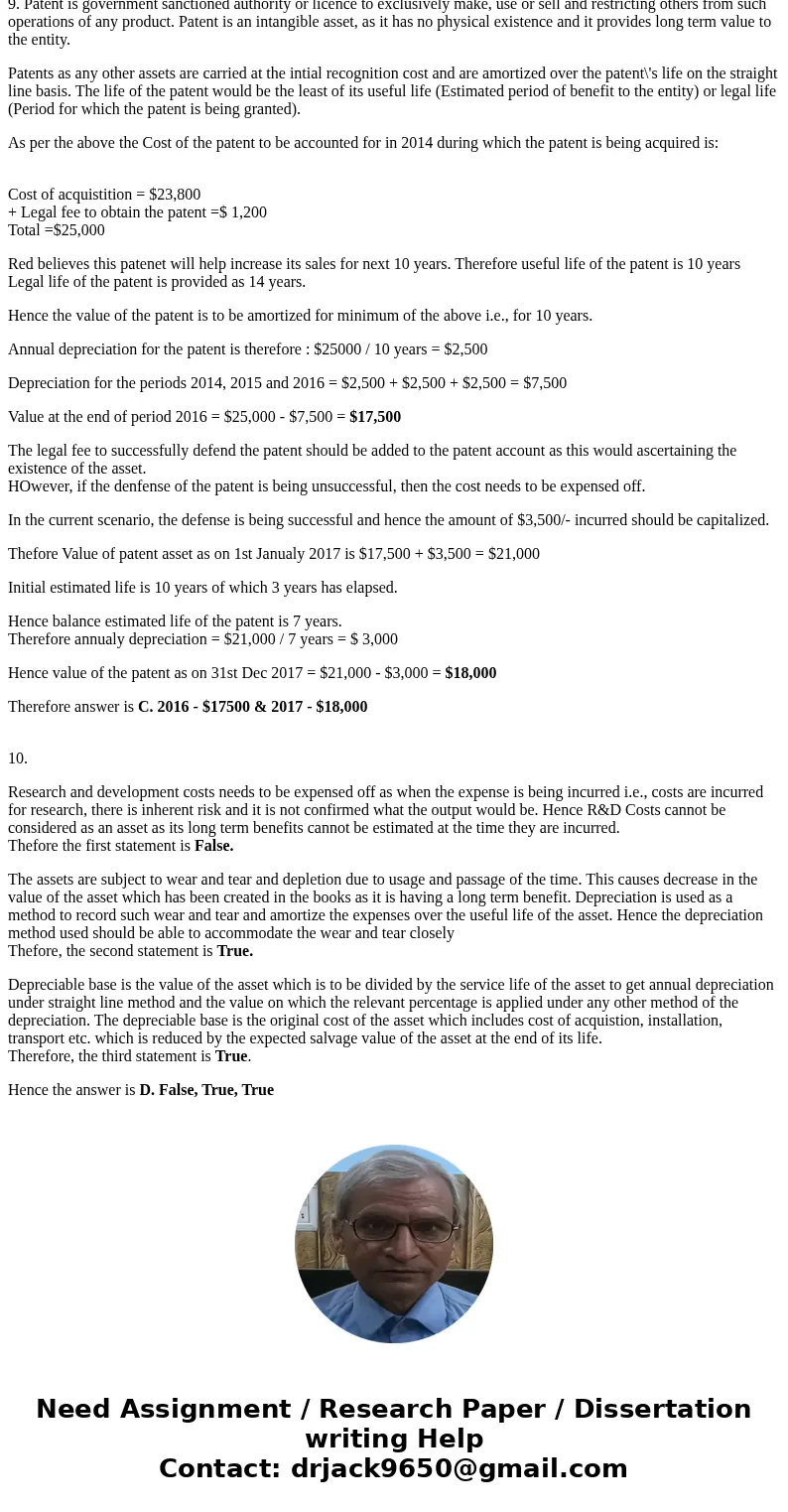9 and 10 PLEASE This is the second time I post this prior p
# 9 and 10 PLEASE! This is the second time I post this, prior person who answered these questions got them wrong!
8. Kidd loc uses the straight-line method of depreciating its plant assets. They had purchased an asset with arn estimated salvage value of S30,000, however; when the bookkeeper calculated and recorded its annual depreciation, she used an estimated salvage value of S3,000. What effect will this mistake have on the accounting equation? Stockholders\' Equit No Effect Understated No Effect Overstated No Effect Assets Liabilities A. Understated B. Understated C. No Effect D. Overstated E. Overstated No Effect No Effect No Effect Qxerstated 9. On January 1,2014, Red Inc. purchased a patent for $23,800. In addition to the purchase price, Red paid legal fees of $1,200 to obtain the patent. Red believes this patent will help to increase its sales for the next 10 years however; the legal remaining life on the patent is 14 years. On January 1,2017, Blue was sued for patent infringement and had to spend $3.500 in legal fees to successfully defend the patent. Determine the book value on this patent at the end of both 2016 and 2017. A. ?. E. 2016 $2500 $25,000 $17,500 $17,500 $21,000 2017 $2,500 $28,500 $18,000 $15,000 $18,000 10. Answer the following true/false questions and then select the correct multiple choice answer: and Development costs should be added to the costs of a patent and then amortized over the lesser of its useful or legal life. A,company should use the depreciation method that most closely resembles the physical wear of the asset. depreciable base of a long term asset is the cost of the asset less the salvage value and is maximum amount that asset should be depreciated. A. True, True, True B. True, True, False C. True, False, True D. False, True, True E. False, False, FalseSolution
9. Patent is government sanctioned authority or licence to exclusively make, use or sell and restricting others from such operations of any product. Patent is an intangible asset, as it has no physical existence and it provides long term value to the entity.
Patents as any other assets are carried at the intial recognition cost and are amortized over the patent\'s life on the straight line basis. The life of the patent would be the least of its useful life (Estimated period of benefit to the entity) or legal life (Period for which the patent is being granted).
As per the above the Cost of the patent to be accounted for in 2014 during which the patent is being acquired is:
Cost of acquistition = $23,800
+ Legal fee to obtain the patent =$ 1,200
Total =$25,000
Red believes this patenet will help increase its sales for next 10 years. Therefore useful life of the patent is 10 years
Legal life of the patent is provided as 14 years.
Hence the value of the patent is to be amortized for minimum of the above i.e., for 10 years.
Annual depreciation for the patent is therefore : $25000 / 10 years = $2,500
Depreciation for the periods 2014, 2015 and 2016 = $2,500 + $2,500 + $2,500 = $7,500
Value at the end of period 2016 = $25,000 - $7,500 = $17,500
The legal fee to successfully defend the patent should be added to the patent account as this would ascertaining the existence of the asset.
HOwever, if the denfense of the patent is being unsuccessful, then the cost needs to be expensed off.
In the current scenario, the defense is being successful and hence the amount of $3,500/- incurred should be capitalized.
Thefore Value of patent asset as on 1st Janualy 2017 is $17,500 + $3,500 = $21,000
Initial estimated life is 10 years of which 3 years has elapsed.
Hence balance estimated life of the patent is 7 years.
Therefore annualy depreciation = $21,000 / 7 years = $ 3,000
Hence value of the patent as on 31st Dec 2017 = $21,000 - $3,000 = $18,000
Therefore answer is C. 2016 - $17500 & 2017 - $18,000
10.
Research and development costs needs to be expensed off as when the expense is being incurred i.e., costs are incurred for research, there is inherent risk and it is not confirmed what the output would be. Hence R&D Costs cannot be considered as an asset as its long term benefits cannot be estimated at the time they are incurred.
Thefore the first statement is False.
The assets are subject to wear and tear and depletion due to usage and passage of the time. This causes decrease in the value of the asset which has been created in the books as it is having a long term benefit. Depreciation is used as a method to record such wear and tear and amortize the expenses over the useful life of the asset. Hence the depreciation method used should be able to accommodate the wear and tear closely
Thefore, the second statement is True.
Depreciable base is the value of the asset which is to be divided by the service life of the asset to get annual depreciation under straight line method and the value on which the relevant percentage is applied under any other method of the depreciation. The depreciable base is the original cost of the asset which includes cost of acquistion, installation, transport etc. which is reduced by the expected salvage value of the asset at the end of its life.
Therefore, the third statement is True.
Hence the answer is D. False, True, True


 Homework Sourse
Homework Sourse